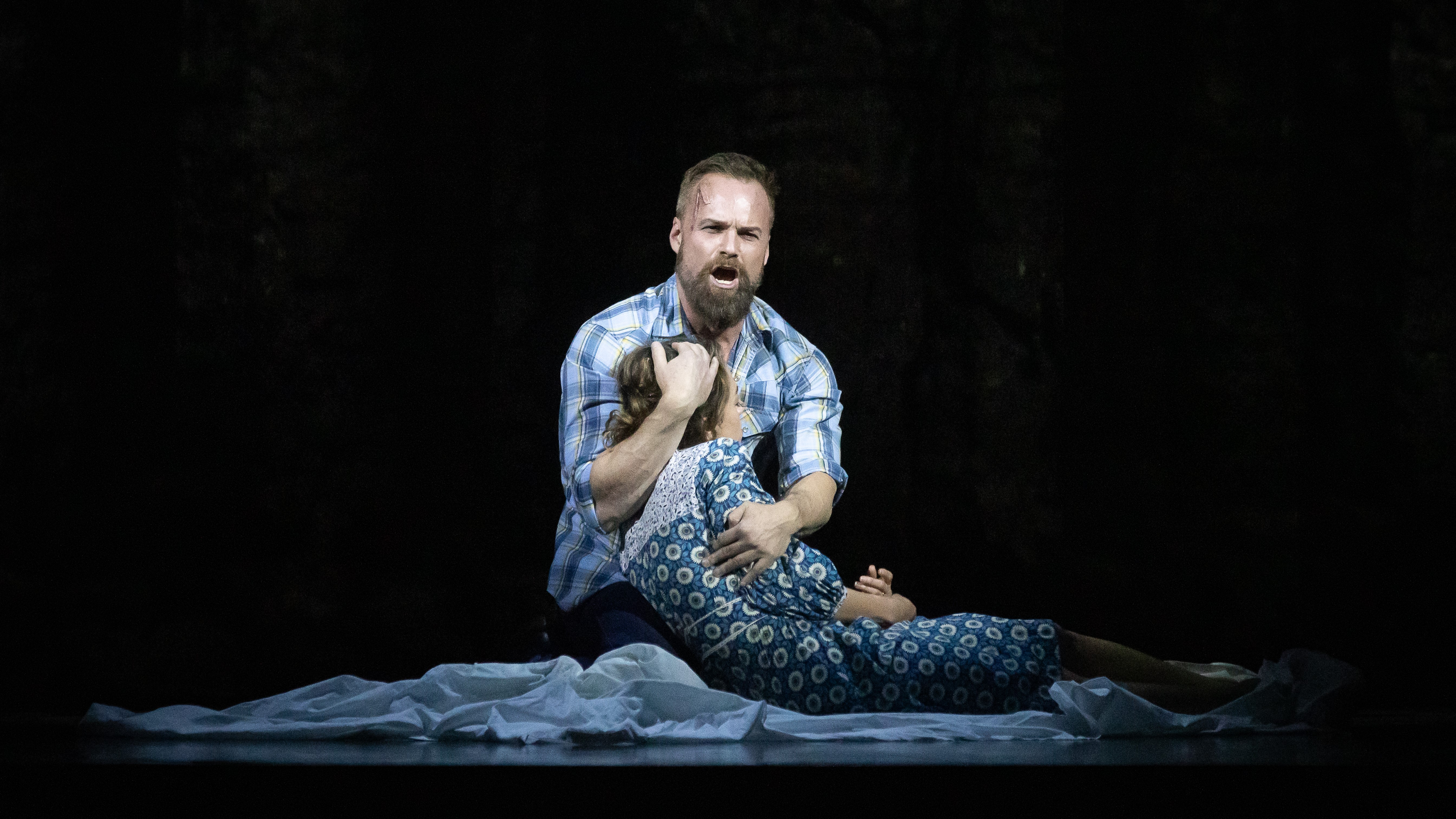Breaking the Waves Listening Guide: An Interview with Composer Missy Mazzoli and a Deep Dive into Her Score
Breaking the Waves, by American composer Missy Mazzoli and Canadian librettist Royce Vavrek, is one of the latest in an expanding repertoire of operas adapted from original screenplays. Based on the 1996 film by Lars von Trier, Breaking the Waves is a veritable blockbuster among these celluloid operas. Since its 2016 Opera Philadelphia premiere, the work has been performed by over a dozen companies. Houston Grand Opera’s production, staged by British director Tom Morris, runs from April 19 through May 4, 2025.
Von Trier’s film is ripe for operatic treatment, owing to the absence of any original soundtrack. There are only a few moments when music is heard in the movie, notably during the chapter title cards. To establish the time setting, these are backed by clips from 1970s rock hits by artists like Elton John and David Bowie. Otherwise, the film is a blank sonic canvas for a composer like Mazzoli to fill.
Moreover, von Trier’s harrowing tale is already reminiscent of opera’s most gripping dramas, with a self-sacrificing protagonist placed in an impossibly extreme dilemma. Mazzoli heard musical potential in Bess’s complex sexual, psychological, and spiritual journey.
“My goal in writing music of any kind, whether it’s opera or anything else, is to speak to emotions that we feel, but can’t express,” says Mazzoli. “So I think that the music is only complete when people hear it and bring their own experience to it.”
In other words, Mazzoli wants to leave some aspects of her art up to the listener’s subjective interpretation. She has a distinct aversion to anything cut and dried, preferring instead the ineffable and the ambiguous.
“I’m really not interested in writing works that have a clear heroine and a clear villain and a clear, black-and-white, conventional morality. I really want people to come out of the theater asking more questions than they went in with, and this is an aspect of my work that infuriates some people. But I will stand by it until the end of time.”
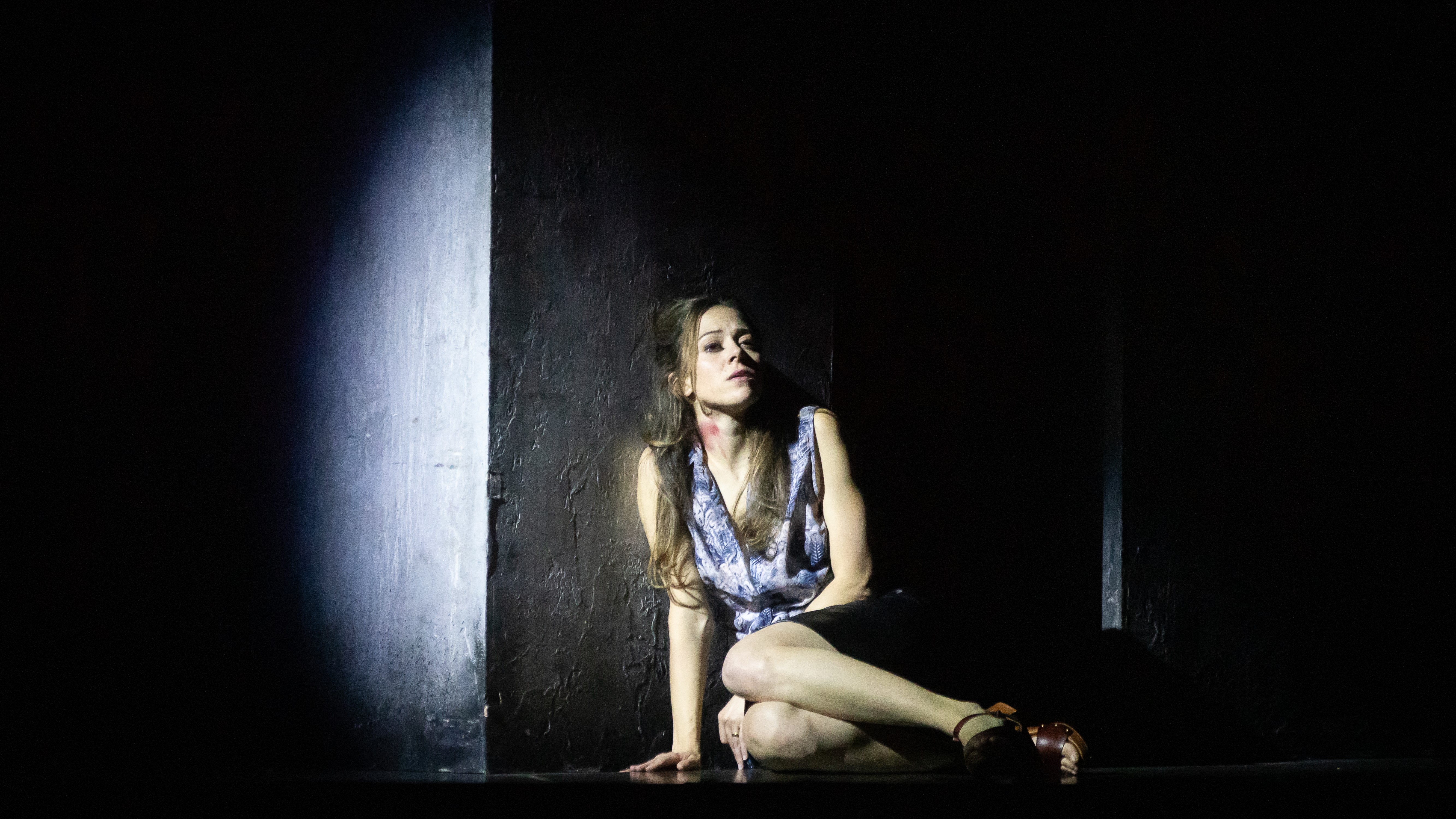
The composer’s musical style is ideally suited to the rich emotional landscape of Breaking the Waves. In particular, her singular harmonic language—which simultaneously upholds and undermines traditional tonality—captures the unsolvable ethical quandaries von Trier raises in his film.
“Often the way I start writing is to think about how to subvert people’s expectations,” she explains. “A major chord becomes something very different and unfamiliar if you put the minor third of that chord in the bass. That gives me a lot of flexibility, because I can choose to follow where the music goes in terms of traditional harmony, or I can choose to keep warping and leaning into the dissonance, driven by the drama of the story.”
Mazzoli also points to her predilection for scales and glissandos (i.e. sliding tones), which, when layered over harmonies, “bring instability into otherwise tonal moments.”
Most of the scenes in Breaking the Waves are organized around a characteristic ostinato (i.e. a repeating musical pattern), revealing Mazzoli’s roots in minimalism and its offshoot post-minimalism. She studied with David Lang and Louis Andriessen and worked for Meredith Monk—all composers associated with the style. Among minimalist operas that inspired her, she lists John Adams’s Nixon in China (which premiered at HGO in 1987) and Doctor Atomic, as well as Philip Glass’s Einstein on the Beach.
But wary of being pigeonholed, Mazzoli emphasizes other influences beyond minimalism that she’s absorbed. She specifically cites the importance of three major British composers in developing her operatic voice: Benjamin Britten, George Benjamin, and Thomas Adès. Puccini, too, played a crucial role. In Tosca, especially, she senses strong parallels with Breaking the Waves: “A woman is put into an impossible situation and forced to do something extreme to get out of it.”
For all its success, Mazzoli and Vavrek’s opera has yet to be recorded. But this will soon change. HGO’s production of Breaking the Waves, conducted by Artistic and Music Director Patrick Summers, will be captured live and released on CD. But in the meantime, the following listening guide—enhanced by excerpts from an interview with the composer—is intended to illuminate the “strange, beautiful music” of Mazzoli’s score.
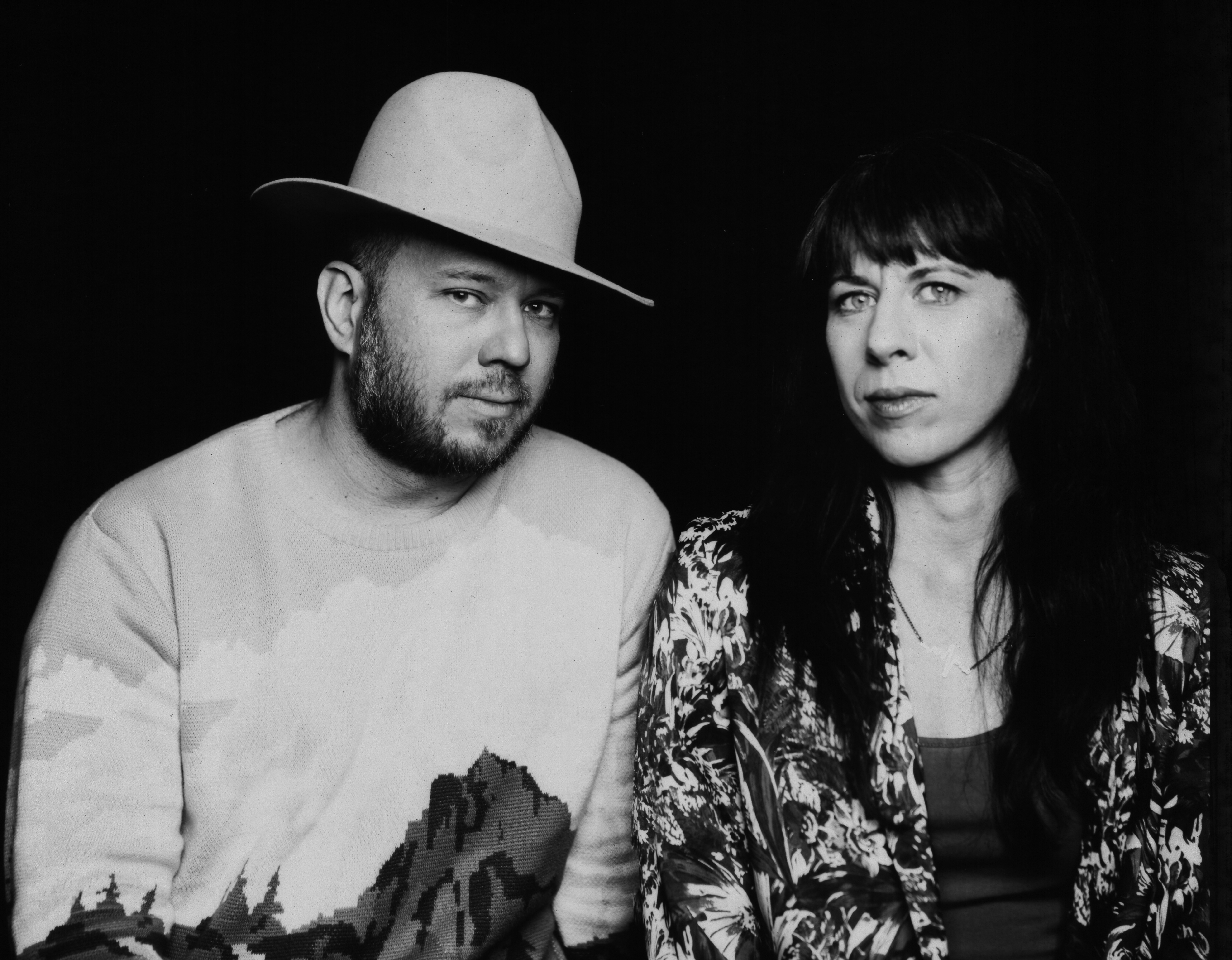
Missy Mazzoli
Royce Vavrek
Breaking the Waves
Based on the Film by Lars von Trier
(Zentropa Entertainments3)
HGO Cast
Bess McNeill (lyric soprano), a young Scottish woman: Lauren Snouffer
Jan Nyman (baritone), a Norwegian oil-rig worker, Bess’s husband: Ryan McKinny
Dodo McNeill (mezzo-soprano), Bess’s sister-in-law, a nurse: Maire Therese Carmack
Terry (bass-baritone), Jan’s colleague and best friend: Sam Dhobhany
Dr. Richardson (tenor), an English physician: David Portillo
Mother (dramatic soprano), Bess’s mother and Dodo’s mother-in-law: Michelle Bradley
Councilman (bass-baritone), the head of Bess’s church: Michael Mayes
Sadistic Sailor (bass-baritone), a crewmember of a commercial ship: Johnny Salvesen
Young Sailor (tenor), his colleague: Andrew Surrena
Church Elders, Rig Workers, Voice of God (tenors and basses/baritones only): HGO Chorus
Chorus Director: Richard Bado
Conductor: Patrick Summers
HGO Orchestra
Setting: Isle of Skye, Scotland, mid-1970s
Content advisory: This production contains explicit material, sexual violence, and nudity.
Part 1: His name is Jan
Prelude
In the opera’s opening measure, the full orchestra hammers out a massive fortissimo chord on a short-long rhythm. This pillar-like harmony, emphasized by a bass-drum stroke, is constructed from two triads: C-sharp major and D major. Both chords are innocuous enough on their own, but when combined in this way, they clash uncomfortably.
“In all of my work,” says Mazzoli, “I’m interested in using musical elements that are very familiar, but presenting them in a context that is unfamiliar—or in this case, juxtaposing them in a way that is unfamiliar. So in this chord, you have two major chords, but they’re a half-step apart and layered on top of each other.”
The harmony carries on in the strings, ebbing and swelling in alternating diminuendos and crescendos. Shrieking flute and clarinet figures imitate squawking waterbirds, while the scraping of a brake drum (the actual car part) evokes the industrial din of an offshore oilrig.
This sonic seascape was inspired by a real location. In researching the opera, Mazzoli and Vavrek traveled throughout Scotland in 2014, including to the Isle of Skye, where the opera takes place. Here, they were overwhelmed by the island’s sublime natural beauty. The dramatic sea cliff at Neist Point—which appears in von Trier’s original film—moved Mazzoli deeply.
“It’s this typical Scottish landscape where a beautiful, lush meadow drops off into the sea,” recalls Mazzoli. “I very clearly heard how the opera was supposed to begin. It was the violence of the landscape that led me there. I heard these big crashing chords. You can hear it as the waves crashing against a rock. Or you can hear it as the sound of God—this ever-present, oppressive force that is acting on our main character.”

“His name is Jan”
In her introductory aria, Bess asks the church Elders for permission to marry her sweetheart Jan, a Norwegian oil-rig worker. She opens with a rising F-sharp octave on the words “His name is Jan,” supported by an F-sharp-minor chord in string harmonics. The key of F-sharp—either major or minor—is closely associated with Bess. However, while Mazzoli utilizes tonal harmonies in her musical language, she also points out that “things rarely fall concretely into a clear key for more than a couple of chords.”
This number lays out the main vocal features of the role. Bess’s wide, playful leaps—evocative of a playground chant—convey a childlike naivety. But her halting, staccato delivery, broken up by rests, reveals her discomfort at addressing these patriarchal authorities. As she speaks of her love for Jan, her confidence grows, and her phrases lengthen into legato flights of lyricism in the singer’s upper register.
Listen for the following phrases in the aria, which recur throughout the opera: “when two people are joined in God,” “Missus Jan from the Rig,” and “the whole community will know our love.” While not strict leitmotifs, Mazzoli does preserve their general musical character on each iteration, especially the syncopated rhythm of “when two people.” At the climax of her aria, Bess remarks that Jan’s name (“funny name for a man”) sounds like bells to her ears. Her ebullient repetitions of “Jan, Jan, Jan” are meant to evoke pealing church chimes.
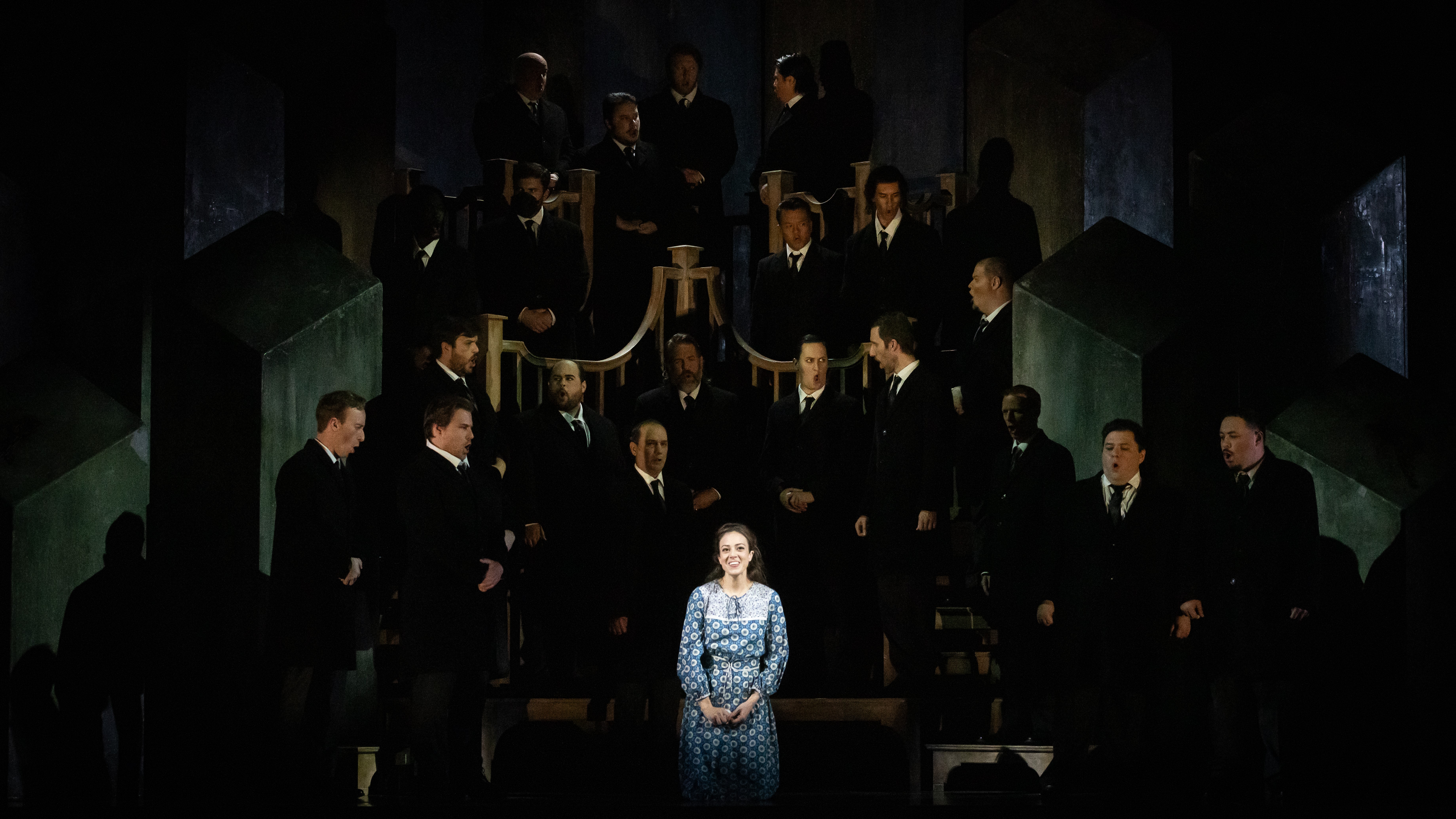
Part 2: We do not favor matrimony with outsiders
Supported by a dry piano-and-woodblock ostinato, the Councilman and Elders question Bess in clipped chanting, marked “typewriter-like.” They tend to sit on a reciting tone, interrupting their monotone line with abrupt leaps. “The men of the church speak in a very angular, boxy way—creating these boxes around Bess,” explains Mazzoli. “That’s meant to convey that they’re very self-assured, backed up by God and millennia of patriarchy. They’re the voice of authority.”
When they’re ready to deliberate, the Elders intone, “Out you go Bess McNeill,” with a hissing “ss” on her name—these words will take on a different meaning later in the opera. But before Bess exits, the Councilman asks whether outsiders like Jan have brought anything of value to the community, to which she responds, “Their beautiful music” over ethereal string harmonics. It’s an echo of a line from “His name is Jan,” when Bess calls Jan her “strange, beautiful music.”
Scene 1: Wedding
As Bess waits for Jan to arrive for their wedding, Mazzoli introduces a turn-like motive in the cellos consisting of triplet 16th notes and a held pitch. “It appears whenever she’s longing for him,” says Mazzoli. “When he’s late to the wedding, we hear this sadness before it bubbles over into tears. It’s this feeling of separation from her husband.”
String tremolos, imitating the pulsing of a helicopter blade, announce Jan’s arrival on Skye by chopper. He answers Bess’s furious, rapid-fire repetitions of “late, late, late” with good-humored affection. “Jan is pure masculine confidence,” says Mazzoli. “I wanted to establish that, so that when we take it away from him, when he’s injured, he becomes this ghost of himself.”
Before the wedding commences, Bess anticipates that Jan will inevitably have to fly back to the rig after they’re married. Mazzoli introduces a plaintive motive in the first violins. Marked “icy,” it’s characterized by wistful, upward-skipping leaps to held top notes. The composer calls this Bess’s “anxiety motive”: “It’s this sort of premonition that things are going to go wrong.”
During the ceremony, Bess and Jan recite vows from a genuine Calvinist wedding service. Bess and her neighbors belong to a strain of Calvinism called the Free Presbyterian Church of Scotland. When the ceremony concludes, listen for the contrast between the Elders’ solemn hymn tune on “Praise be given ever more” (mi-re-do-re-mi) and Bess’s ecstatic cries of “Alleluia!”
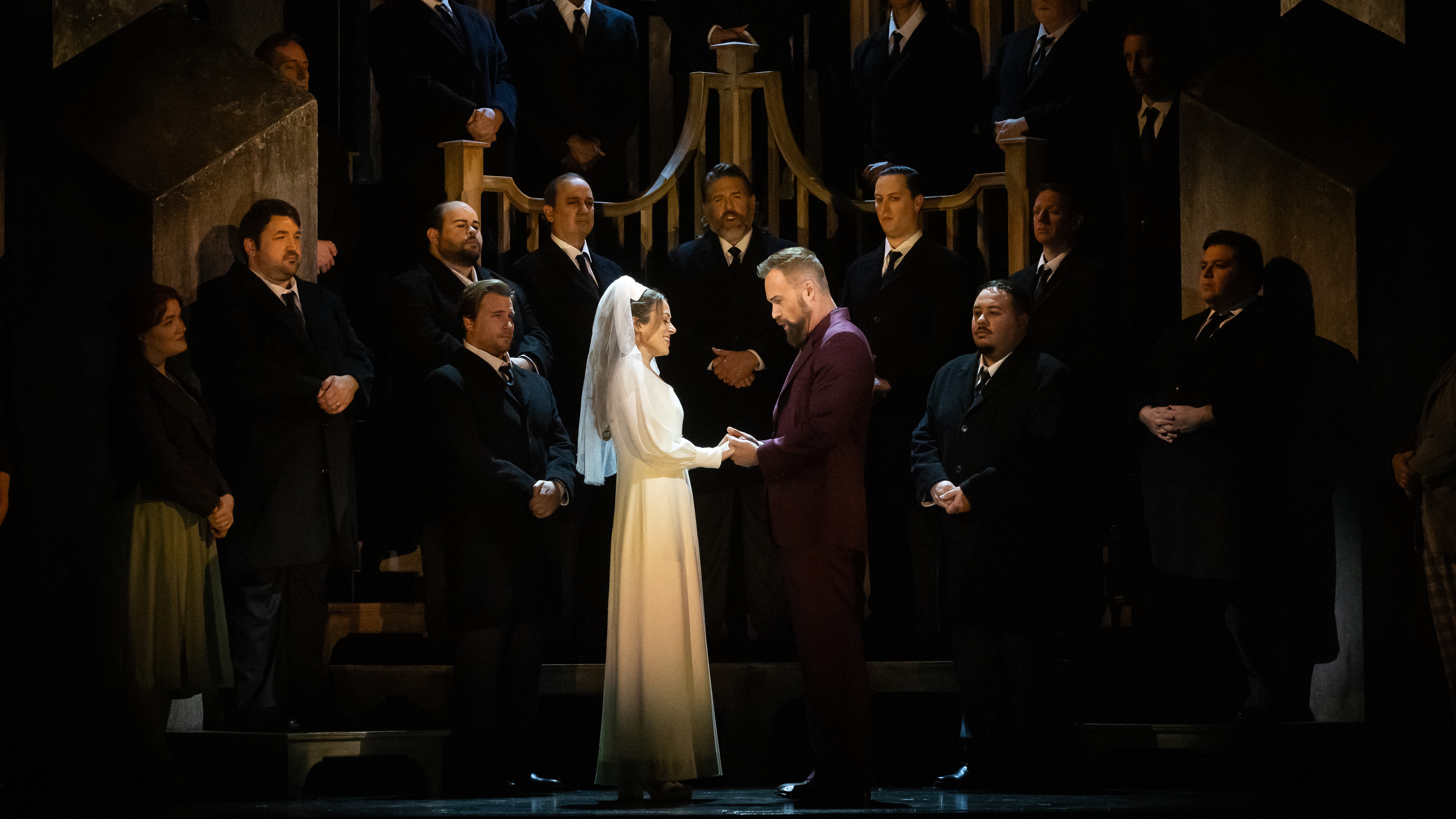
Scene 2: Reception
The centerpiece of this scene is Dodo’s tender reception speech, in which she praises Bess’s “golden heart.” This phrase—sung on an F-sharp-major melisma—is lifted from von Trier, who grouped Breaking the Waves with his films The Idiots (1998) and Dancer in the Dark (2000) into the “Golden Heart Trilogy.” Named after a picture-book from the director’s childhood, this trio of unconnected stories deals with three heroines who personify goodness, sacrificing themselves for a cause or a loved one.
Dodo’s speech is accompanied by a gently tolling ostinato on vibraphone, piano, and harp. Over this, the clarinets and flutes play skipping short-long figures. It’s a rhythm known as the “Scotch snap” for its ubiquitous presence in Scottish folk music. Although Dodo herself is not Scottish, Mazzoli explains that the rhythm “is meant to convey her steadfastness. She’s a rock for Bess. She is a source of stability and maternal love—the love that Bess doesn’t get from her mother.”
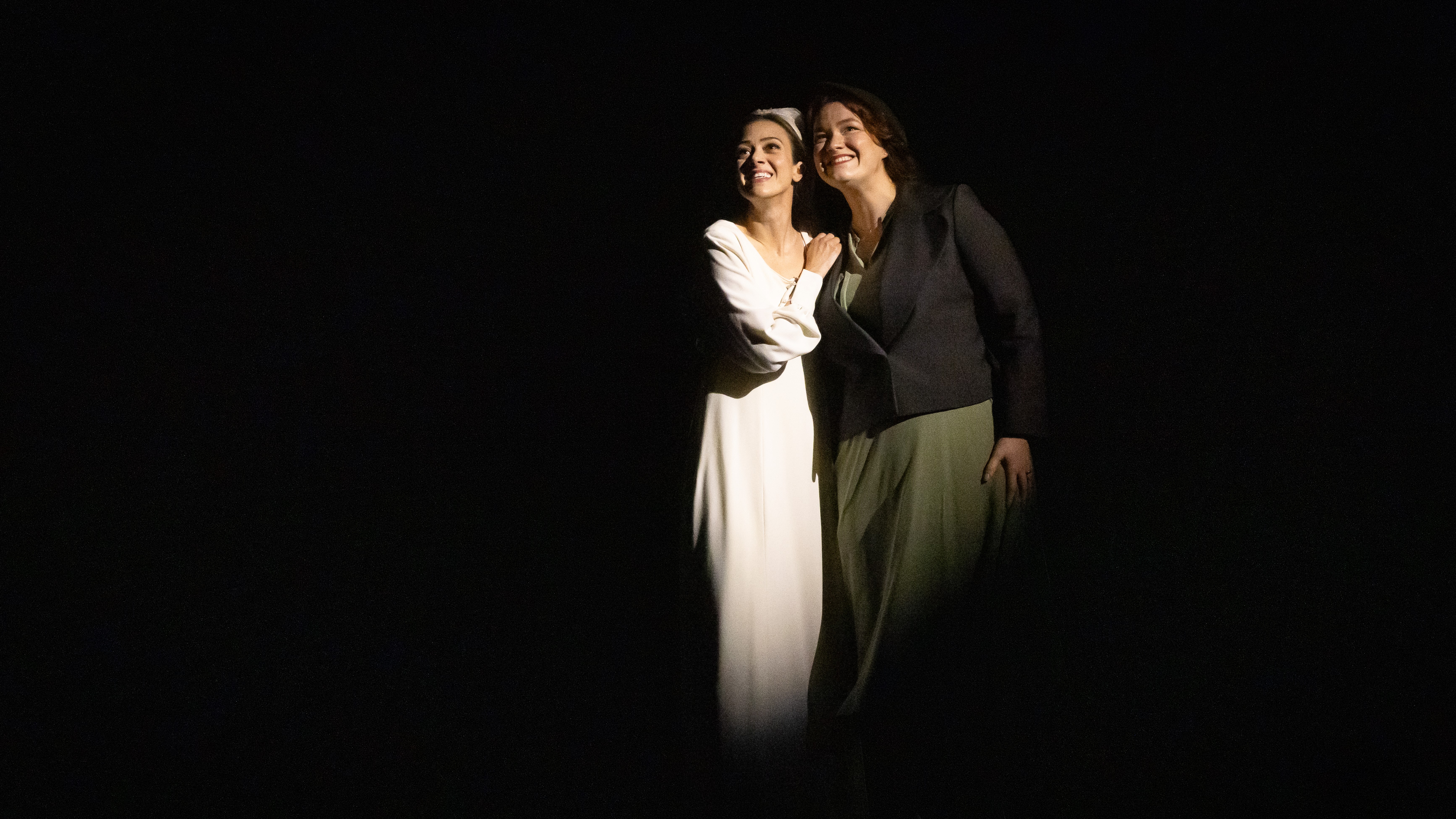
Bess recites the “when two people are joined as one” motive to herself. Eager to fulfill this holy vow, she leads Jan into the bathroom, where they make love for the first time. Listen for the suggestively rising trombone slide—such glissandos are often connected with male sexuality in the opera. Meanwhile, from the reception hall, we hear the Elders intoning their hymn theme from the previous scene on a new text taken from Psalm 18:26: “With the pure thou wilt shew thyself pure; and with the froward thou wilt shew thyself froward.”
Scene 2 ends with an orchestral texture that is pervasive in Mazzoli’s score, usually appearing during scene transitions: a sequence of staggered, descending scales that overlap in various instrumental parts. In this case, they’re pitched in F-sharp major. But elsewhere in the opera, these scales are transposed to different keys and modes, with variations in rhythm, tempo, length, and contrapuntal density.
At first glance, these cascading scales might seem to represent the waves of von Trier’s title. However, Mazzoli reveals that this texture doesn’t have any aquatic associations. She points out that, although the opera takes place in a seaside village, “it’s not really about the ocean. I think of the title more symbolically. Bess is this person who is breaking the wave of tradition in this community.” Even if these scales aren’t a literal depiction of waves, we might think of them as a kind of metaphorical vortex or undertow—a sonic representation of the forces that are pulling Bess toward destruction.
Scene 3: Marriage
Alone, Bess thanks God for bringing her Jan. Her invocation “Dear God” rises heavenward in an ascending motive that opens most of her prayers in the opera. This is the first time that we encounter Bess’s “God voice”—a half-sung, half-spoken form of vocal delivery known as Sprechstimme. “In the movie, when Bess talks to God and then answers in God’s voice, it’s like she’s imitating the voices of the men of the church,” says Mazzoli. “She affects this low, scolding voice. I wanted it to be really strange. I wanted it to be like she was possessed.”
The use of Sprechstimme recalls Arnold Schoenberg’s biblical opera Moses und Aron, in which the voice of the Almighty is assigned to an unseen Sprechstimme chorus. Mazzoli also employs a chorus to amplify and echo Bess’s lines, though they sing in full voice. Their two-part canons and chorales purposefully resemble the psalms and hymns of the church Elders.
“It’s a shocking moment,” says Mazzoli, “so I wanted something in the orchestra that was equally surprising.” Every time Bess dons her God voice, it’s punctuated by blaring chords from a distorted electric guitar. “Bess’s idea of God is big and otherworldly. But the way that she interprets God and feels God in her life is something bigger than anyone could ever imagine. And she is in love with the music of the outsiders. So God to her is ’70s rock music, and that’s how she expresses it.”
“Your body is a map”
Some time after the wedding, Bess and Jan lie naked together in bed. Bess traces the intersecting paths of their lives in the lines of her new husband’s body. Their voices dovetail—each singing in the other’s rests—before joining in harmony on the words “life together.” It’s a lovely evocation of the converging destinies Bess reads on the imaginary map.
In this love duet, Mazzoli introduces a simple yet effective new leitmotif in the first violins: a rising minor sixth that falls back down to the starting pitch. This soaring, liberatory gesture seems to encapsulate Bess’s sexual awakening. Mazzoli associates it more broadly with the character’s feelings of joy.
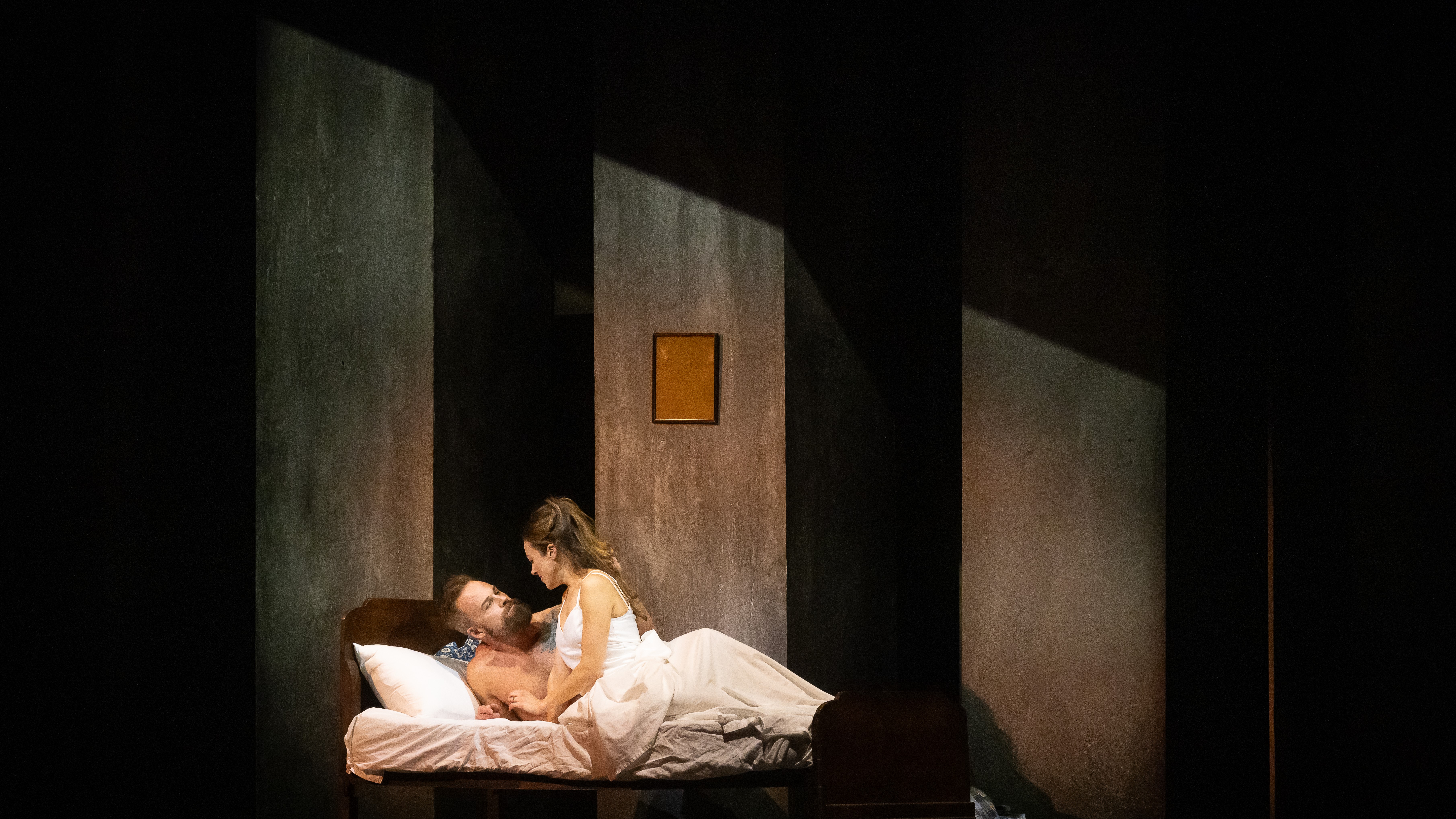
Scene 4: Without Jan
Jan asks Bess why no bells rang at their wedding, and she explains in a kind of folk-ballad arioso that the congregation cast them into the sea long ago. No actual bells appear in Mazzoli’s orchestration here—rather, she simulates their sound through a jingling combination of vibraphone, piano, and harp (the same instrumentation from Dodo’s “golden heart” speech in Act I, Scene 2).
“The final gesture of the whole opera is that we finally hear the bells,” says Mazzoli, “so we can’t hear them before that, otherwise it undermines it. But I do have these ‘fake bells.’ It’s almost like a distant memory of a bell, which is what she’s describing.”
The brake drum reappears when Jan reminds Bess that he will have to return to the rig soon. She refuses to accept this and desperately repeats the words “Mister and Missus Jan” on a bugle-like triplet figure marked “ugly, braying.” Bess’s Mother rebukes her daughter for her behavior.
Mother’s admonition aria is labeled a “Melancholic barcarolle,” a genre of rowing songs in 6/8 time. However, Mazzoli places Mother’s barcarolle in a strange asymmetric meter, alternating between 6/8 and 5/8. Her vocal line is rigid and stern—when she lectures Bess that “Ev’ry woman endures,” she drives her lesson home on four repetitions of a tenacious, upward-climbing motive. As a final warning, she leaves Bess with a Scots Gaelic proverb sung on an oscillating fourth: “Bidh cas an eoin ghoraich san ribe” (The silly bird’s foot will go into the snare).
Tremolo strings signal the arrival of the helicopter that lands to take Jan back to the rig. After his departure, Bess and Dodo watch a funeral from afar—as women, they’re not allowed to participate. This is the burial of a damned man named Antony, who was ostracized from the church. The orchestration here is eerily sparse: organ chords over a droning double bass. The latter gradually descends to an infernal C1, the instrument’s lowest possible pitch. Just before the Councilman consigns Antony’s soul to hell, we hear a ghastly noise—a chain rattling against a tam-tam gong.
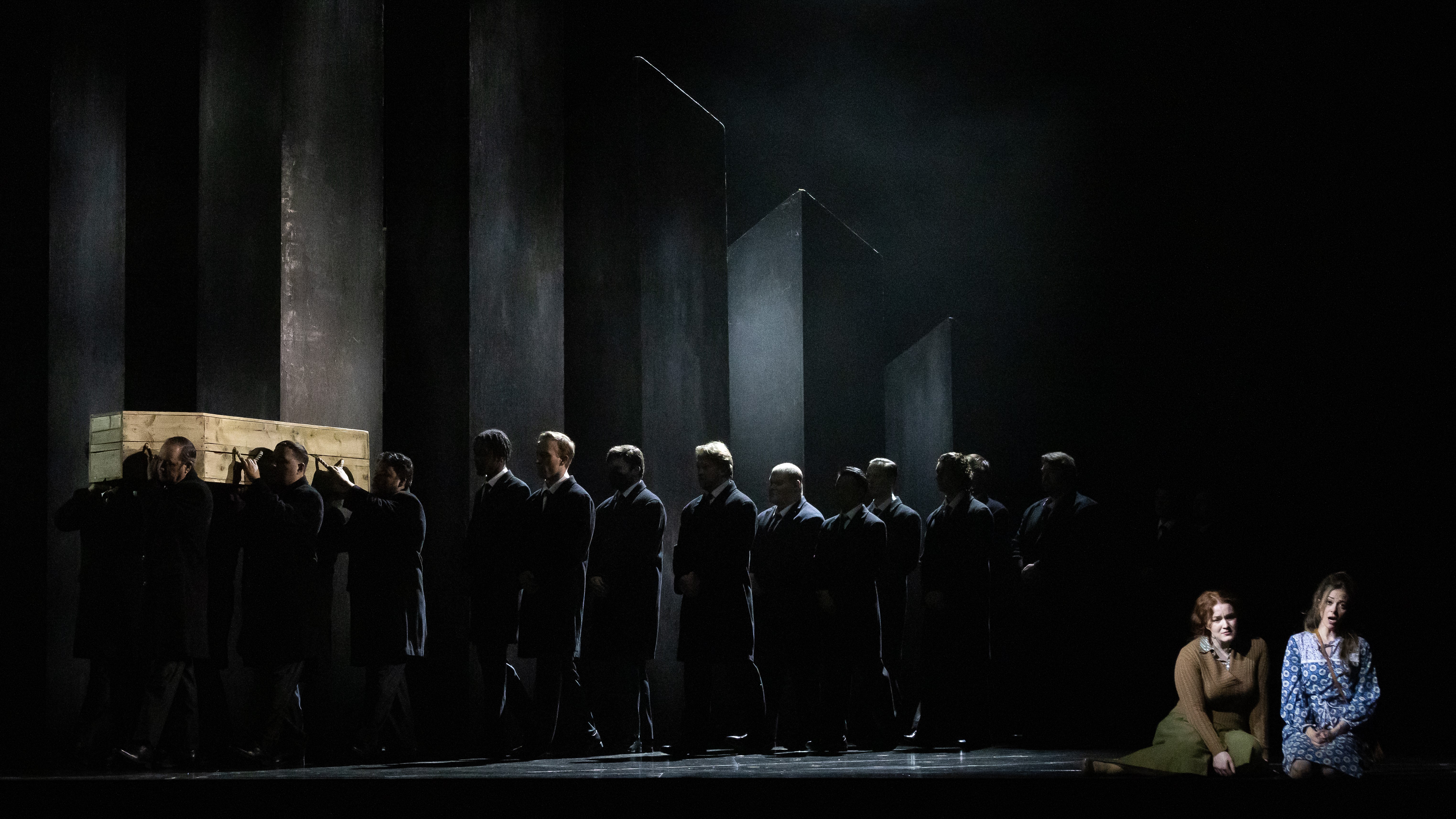
Scene 5: Prayer of a selfish girl
The overlapping scales return in the strings, descending in E-flat major. Bess prays about missing Jan, but she’s rebuked by the voice of God for her selfishness.
Interlude: Horseplay
We hear another set of overlapping scales, now in B-flat major. But this time, their rhythm is more regular—mechanically strict 16th-notes in the violins and violas, sounding straight out of a Vivaldi concerto. This version of the staggered scales is specific to the oil rig, which is where the Interlude unfolds. The clanging of heavy machinery is replicated in the percussion, which features struck car parts like a suspension spring and the brake drum from earlier.
This metallic racket subsides for the rig workers’ song. Marked “macho,” its lyrics are filled with oil-related double-entendres suggestive of sexual violence. The chorus sings mostly in unison, but during the refrain, they harmonize on a painful major second for each repetition of the word “drill.” Listen for the many glissandos in both their vocal line and in the orchestra, again evoking aggressive male sexuality.
Scene 6: Phone booth
While this is not the first opera to depict a phone conversation (see, for instance, Poulenc’s La Voix humaine), it is almost certainly the first to include a scene of phone sex. Bess waits at a phone booth for Jan to call. A playful ostinato in the woodwinds, vibraphone, and piano suggests a ringing phone—another instance of Mazzoli’s “fake bells.” Exhilarated by the sound of Jan’s breathing, Bess sings “I hear you” on her minor-sixth joy motive from “Your body is a map.”
Their intimate dialogue, a kind of miniature love duet, is suddenly cut short, signaled by a D-flat dial tone on oboe and clarinet. Bess prays, begging for Jan to return sooner than the 10 days until his next visit. The chorus chants that she must learn to endure, calling to mind her Mother’s admonition aria. But Bess has made up her mind—she needs Jan home now.
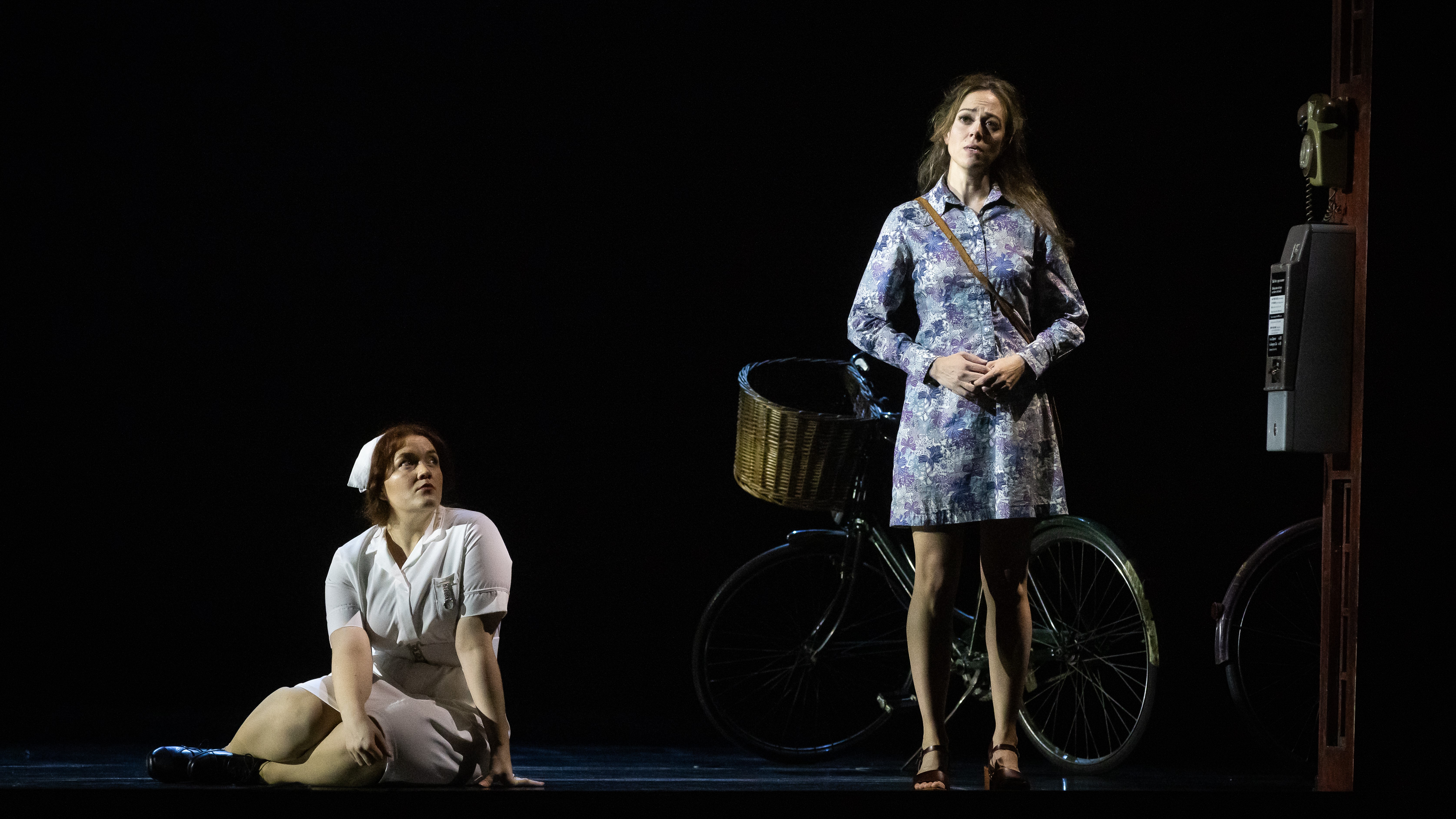
Scene 7: Accident
The orchestra bursts into a pillar-like G-flat maj7 chord on the same short-long rhythm of the opera’s opening harmony. We find ourselves back on the rig, where Jan saves his friend Terry from being injured. But in doing so, he is struck on the head by a drill bit. The moment of his injury is marked by the same ominous combination of organ and chain-struck tam-tam heard during Antony’s funeral in Scene 4.
Jan is rushed to a hospital on Skye. When he realizes he can’t feel Bess’s hand on his, he snaps at her not to touch him. His outburst, “Do as you’re told!,” triggers the electric guitar, as if his command is merging with the voice of God. The violins play desperate iterations of Bess’s joy motive, which is stifled by further electric-guitar chords.
Bess consults with the voice of God, but the chorus rebuffs her, ironically reminding her, “You wanted Jan home.” The guitar feedback increases, and the scraping brake drum enters. Act I ends abruptly when the strings cut off on a grating scratch tone.
Scene 1: Mental health
The orchestra plays the same C-sharp-major/D-major harmony from the beginning of Act I, setting off a flurry of repeated pitches and cluster-chords in the high piano. Throughout the opera, this trembling gesture—marked “spastic”—is meant to elicit apprehension. Speaking with Dr. Richardson, the English physician treating Jan, Bess insists that she’s to blame for her husband’s injury.
“Goodness! What powers you possess!”
In this aria, Dr. Richardson paternally reassures Bess that she’s not at fault. His recurring refrain, “What powers you possess,” is sung on a falling 16th-note run marked “baroque.” These coloratura flourishes lend his vocal line a Handelian character. “He’s the voice of science and reason, and that to me was this fastidious baroque style,” explains Mazzoli. Listen for when, sensing Bess’s virtue, Dr. Richardson changes the text to “What goodness you possess”—a play on his earlier exclamation, “Goodness!”
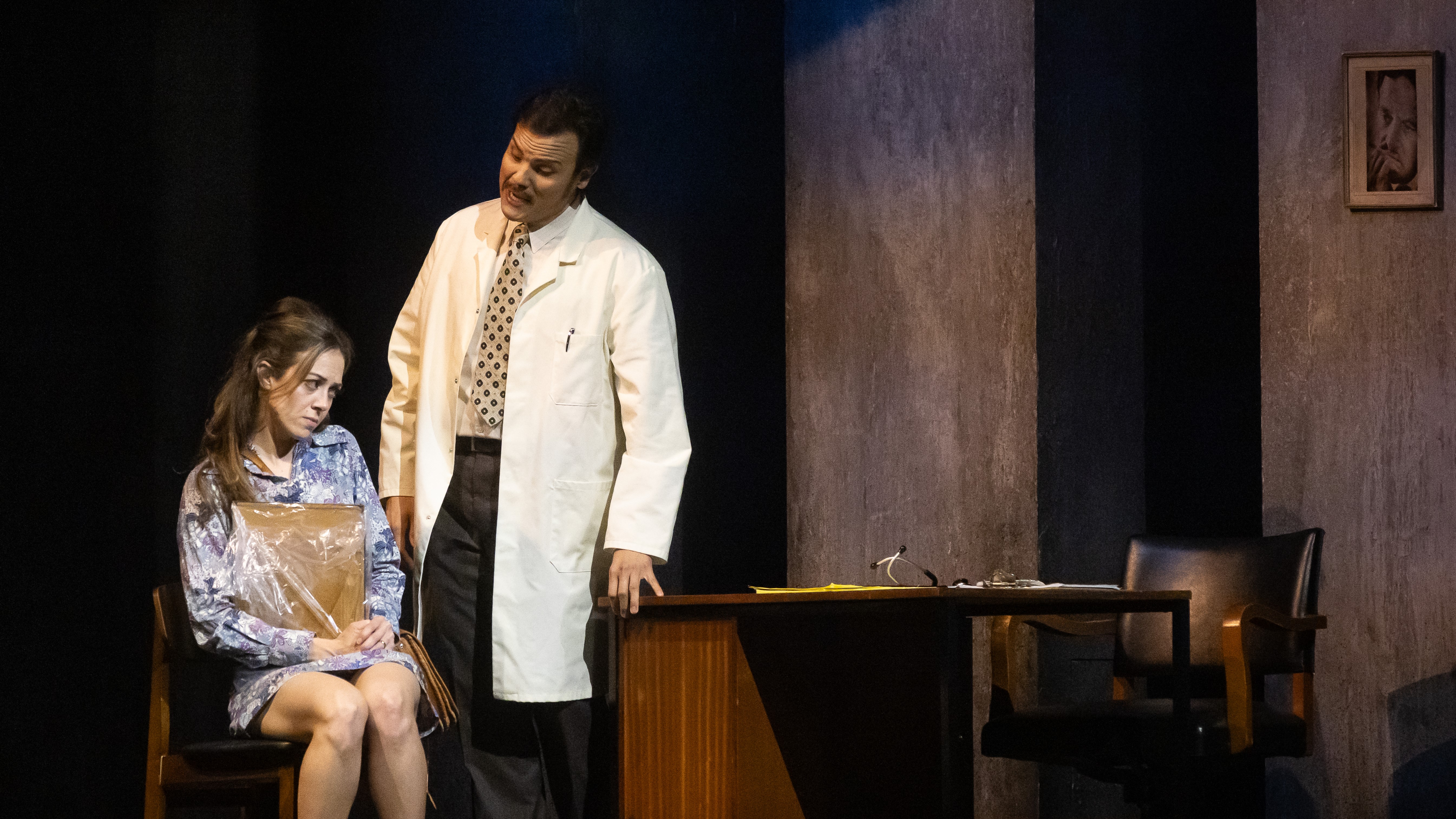
Partway through this number, we hear a new woodwind motive shared among the flute, oboe, and clarinet. Marked “nervous,” this is Dr. Richardson’s theme. It has a rustic, hornpipe-like quality reminiscent of the folk-inflected melodies found in Britten’s Peter Grimes—an opera that Mazzoli points to as an influence on her score.
“When you’re really starting to write opera in English, it’s hard to get away from Britten,” she admits. Though, this nod to Britten is perfectly warranted, as Peter Grimes tells a strikingly similar tale of a protagonist ostracized by a small-minded, seaside community. “So much of Britten’s work is about a figure who’s been cast out,” observes Mazzoli.
Scene 2: Love of my life
Bess visits Jan at the hospital, where she finds him sleeping. The piano takes up a jittery ostinato: wide, broken arpeggios with the hands separated at opposite ends of the keyboard. Meanwhile, the strings reprise the longing motive from Act I, Scene 1. This time, it’s labeled “Languid, a slow Baroque dance,” perhaps a carryover from Dr. Richardson’s Handelian aria.
Jan regains partial consciousness, and in his drugged delirium, he asks Bess an unsettling question: “Do you think we turn bad when we are standing on the edge? When we are going to die?” This line is accompanied by an unexpected instrument: a melodica. Its plastic casing houses a set of free reeds, similar to a harmonica’s. The player blows through a mouthpiece at the top of the instrument and changes the pitch using a handheld keyboard.
Because of its toylike appearance, composers and songwriters typically treat the melodica as a novelty noisemaker. But in this context, it’s a sinister presence. Its dark, reedy timbre recalls the bellows organ that sets a somber mood in the Hades scenes of Monteverdi’s L’Orfeo. Indeed, Bess is something of an Orpheus character herself, attempting to rescue Jan from the underworld of his paralysis.
When Jan poses his disturbing question, the melodica is paired with the organ. More accurately, they are harmonically pitted against one another. Throughout the progression, the two instruments cycle independently through major, minor, or augmented versions of B-flat. But they never align on the same quality of triad—on their first chord, for instance, the melodica’s B-flat minor conflicts with the organ's B-flat major.
“It’s about slipping between worlds,” explains Mazzoli. “Jan is slipping in and out of consciousness, or on the border between life and death. The idea of a major chord that’s sort of ‘tainted’ by a minor third—it leads to this unease. We don’t know where we are in the harmony or in the progression. And we also don’t know where we are in terms of a clear morality.”
This moral ambiguity—so strikingly represented by the competing B-flat chords—emerges in Jan’s plea to Bess. Rendered unable to satisfy his wife because of the accident, he tells her to seek the company of other men. Bess is disgusted by this proposition, which would mean committing adultery, and she storms out of the hospital room.
Interlude: Rig/Elder
Two scenes unfold simultaneously. The men of the rig are working silently, again accompanied by the Vivaldian staggered scales from the Act I Interlude. Meanwhile, on Skye, the church Elders intone portions of the wedding ceremony, sung on their hymn motive. Bess consults privately with the Councilman, who tells her to make up with Jan.
Scene 3: Like being together
Jan attempts to commit suicide, underscored by the melodica/organ pairing. Dodo, who works as a nurse at the hospital, catches him in time and castigates him for abandoning his wife. Bess’s entrance is signaled by the “golden heart” music.
Jan rewords his request to his wife: it’s not for her sake that he wants Bess to seek out other men, but his. When she describes these encounters to him afterward, it will be as if Jan and Bess are making love themselves, and this will grant him the will to live.
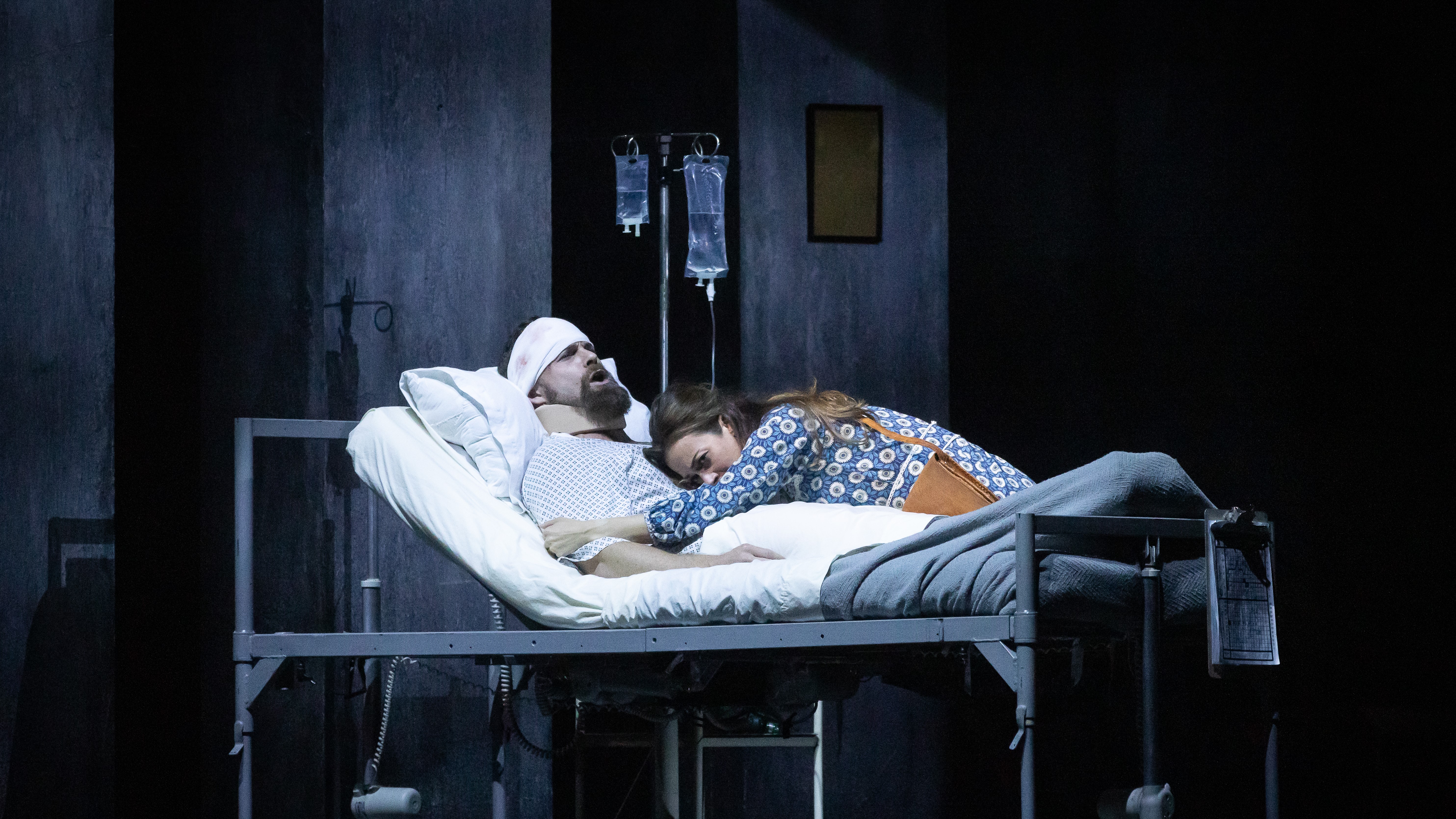
Bess reconsiders, reprising the syncopated “two people joined in God” motive with Jan. It’s as if she’s trying to convince herself that this vicarious lovemaking doesn’t constitute adultery. The couple continues in a brief duet composed of lines from “His name is Jan,” but it’s cut off when Jan’s heart monitor goes off (represented by glockenspiel). Bess prays, and the voice of God instructs her to prove her love by fulfilling the task Jan set for her.
Scene 4: Beers/Bus Stop
As Bess waits at a bus stop, the upward-swinging anxiety motive from Act I, Scene 1, appears in the flute. An unknown man joins her, and she pleasures him discreetly. Bess returns to the hospital to tell Jan. She haltingly recounts an embellished retelling over an uncomfortably empty accompaniment: a droning G in the organ and a timid reprise of the anxiety motive in the first violins. Seeing through Bess’s lies, Jan explodes at her, screaming that he’s “sick in the head.”
Scene 5: Bess’s faith
Dr. Richardson’s folksy woodwind theme returns as Bess goes to visit him. Hoping to seduce the physician, Bess puts on a record to dance to. In von Trier’s original film, the song that plays is “Funeral for a Friend/Love Lies Bleeding” from Elton John’s Goodbye Yellow Brick Road. As a substitute, Mazzoli created a pre-recorded pastiche of 1970s rock. “It’s actually the opening chord of the opera,” reveals Mazzoli, “but translated into guitar, bass, piano, and drumkit, so it feels very different.” The harmony is transposed this time to D-sharp major/E major.
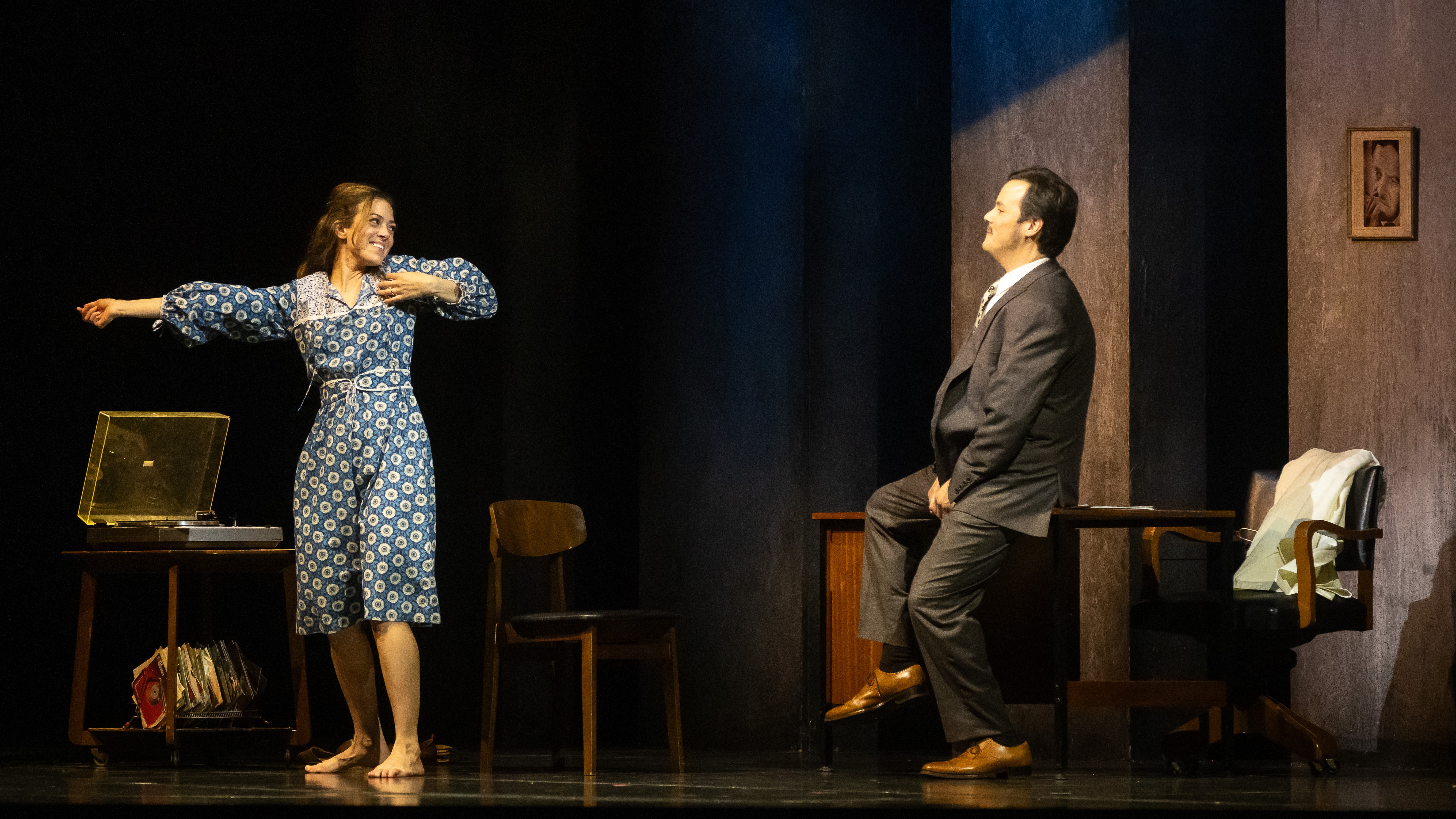
Bess disrobes for Dr. Richardson as the anxiety motive plays in the oboe. He compassionately tells her to leave, and she wanders into a local pub, where she picks up a man. As they have sex, the male chorus embodies the oil-rig workers in the background. They reprise portions of their Act I Interlude song, or else lewdly repeat the moaning syllable “nuh.”
During intercourse, Bess claims she can hear bells chiming Jan’s name, which she repeats on a figure reminiscent of the famous Westminster Quarters rung by many clocks. Meanwhile, Jan’s condition has suddenly worsened. Dr. Richardson applies a defibrillator, and the thumping of its paddles are imitated in a flurry of percussion. Jan’s heart restarts at the height of Bess’s sexual encounter. As in Act I, the strings close the act with a scratch tone.
Scene 1: Ultimatum
An anxiously repeated D at the top of the piano leads into a fortissimo G maj7 harmony in the full orchestra, played on the same short-long rhythm as the opera’s opening chord. Bess reprises her Act I love duet, with the text changed to “My body is a map of my life with Jan.” When she sings that she can save her husband through her liaisons, the first violins play the joy motive.
Bess is confronted by her Mother at home. She warns Bess that she risks being cast out from the church for her promiscuity. Mother’s number is dominated by the oscillating fourth on which she sang the Gaelic proverb in Act I, Scene 4. While this motive is reminiscent of a Hi-Lo emergency siren, Mazzoli explains that she had another sound in mind: “Her mother has been waiting up for her, so I wanted to convey a persistent, ticking clock. It’s a back-and-forth, scolding theme.”
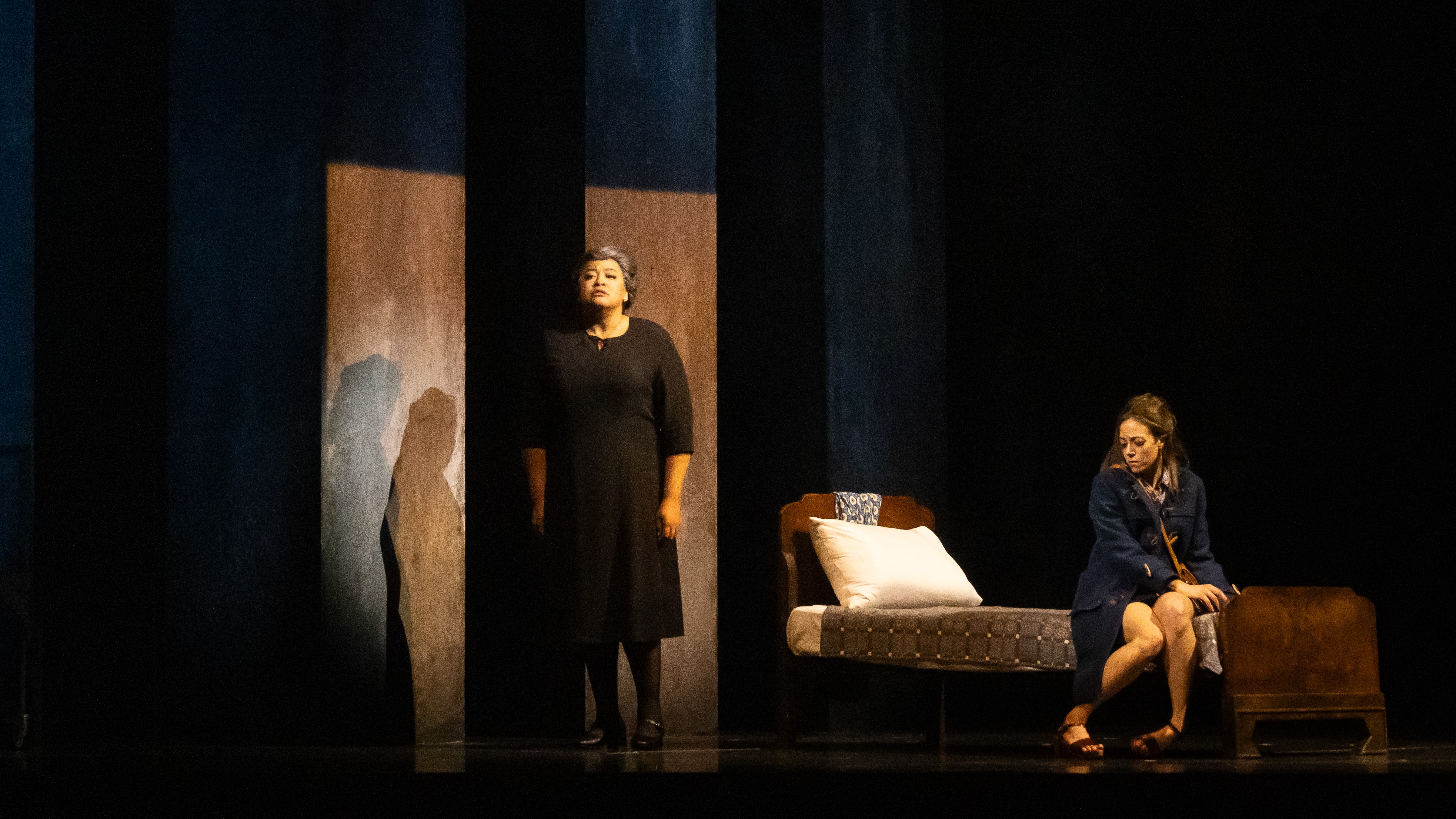
Dodo and Dr. Richardson enter and try to convince Bess that Jan is not in his right mind. They join with Mother in a counterpoint of reproaches, but Bess bursts through their trio on the phrase “Love is a mighty power,” supported by the joy motive in the first violins. She explains that God has given her a special talent—not having sex per se, but the faith to believe that her actions are truly saving Jan. Left alone, she seeks comfort from the voice of God, which doesn’t answer.
Scene 2: Jan commits Bess
[omitted for HGO’s production, with Mazzoli and Vavrek’s approval]
Scene 3: Red boat, Part I
Bess climbs aboard a commercial ship to proposition the crew. Glissandos in the trombone, strings, and buzzing harp imitate the rocking of the boat, inducing a queasy sensation of seasickness. The Sadistic Sailor and Younger Sailor treat Bess roughly, and she threatens them with a gun before making her escape.
Scene 4: House of God
The Councilman preaches, and the Elders—divided into three parts—echo lines from his sermon in staggered entrances. Variations of this technique have been heard throughout the opera to represent the voice of God. Referred to as “lining out,” its origins lie in Gaelic psalm singing—a Presbyterian musical tradition native to Scotland’s Western Isles.
Mazzoli explains how this form of worship works: “The minister will recite a phrase, and then the congregation responds with a different phrase that they all know. They sing it, but they don’t try to line up with each other. So it’s sort of like a washy utterance from a congregation—kind of the same notes, but not at the same time. I’d never heard music like that. It wasn’t about lining up with your neighbor, but it was a communication between you and God. So I made my own version of that.”
Bess stumbles into church and interrupts the Councilman, who has just emphasized the importance of loving the law. “You can only love another human being,” Bess counters. “That is perfection.” As a woman, she’s forbidden to speak in church. The Councilman and Elders excommunicate her, intoning “Out you go, Bess McNeill” on the same boxy theme from Part 2 of the Prologue.
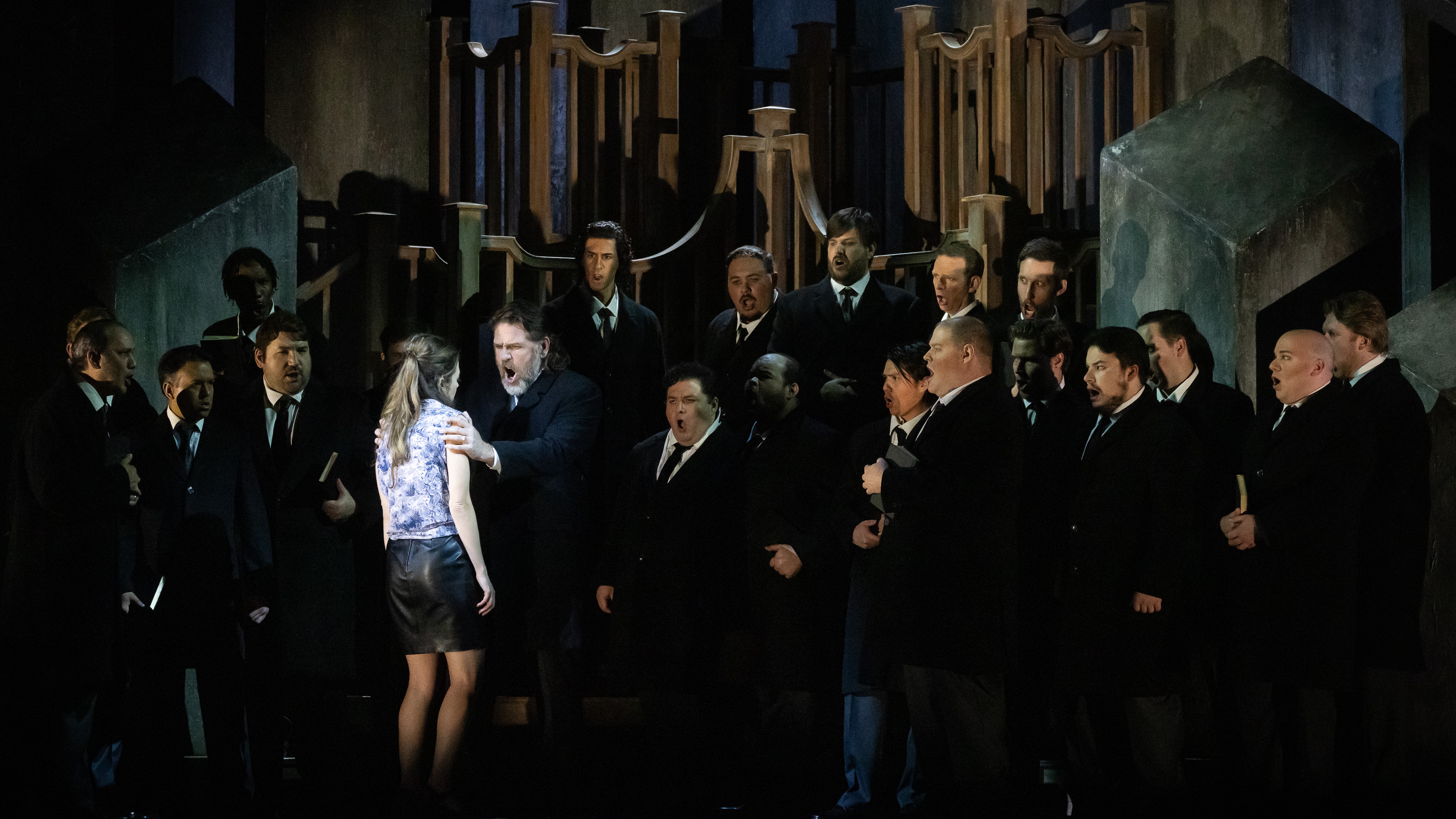
Bess seeks refuge at home, but her Mother has locked her out. She’s accosted by a group of village men, who call her a tart. Dodo intervenes, accompanied by the “golden heart” music, and informs Bess that Jan’s condition has worsened beyond all hope. With new resolve, Bess sets out toward the red boat again.
Knowingly heading toward her destruction, she offers up one last prayer. The voice of God finally responds in full force. Over thunderous electric guitar, the chorus repeats the comforting phrase “I am with you” and urges Bess to “complete the task.” They reassure her that “I am wide awake” on an F-sharp-major chord, eventually setting off a sequence of ascending staggered scales in the orchestra—the only time in the score when this motive is directed upward.
Scene 5: Red boat, Part 2
Bess gives herself over to the Sadistic Sailor and the Young Sailor, who rape and maim her. Backed by the full orchestra, the chorus and four other soloists (i.e. Mother, Dodo, Dr. Richardson, Councilman) build toward a massive, hymnlike statement of the psalm verse from Act I, Scene 2: “With the pure thou wilt shew thyself pure and with the froward thou wilt shew thyself froward.” The ensemble cuts off suddenly, and the ensuing silence is broken by the return of the opening chord of the opera, now transposed to B major/C major.
Bess is taken to the hospital as the solo flute plays a poignant reprise of “His name is Jan.” Bess sings scattered snatches from that aria as Dodo and Mother comfort her. Before dying, she repeats Jan’s name on the tolling Westminster Quarters motive from Act II, Scene 5. The orchestra unleashes staggered downward scales, as if mourning Bess’s sacrifice.
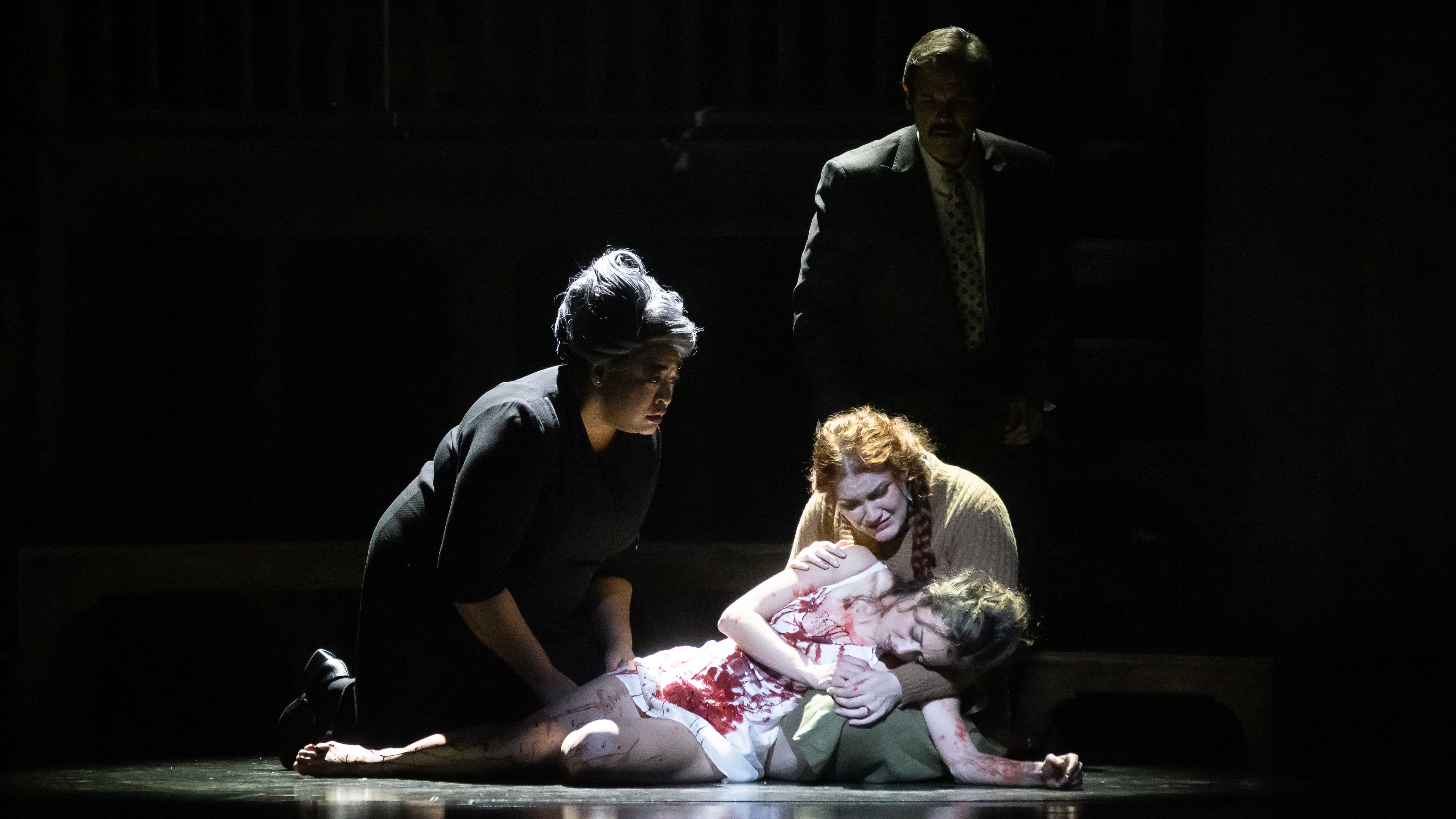
Scene 6: Doctor’s report
Dr. Richardson, accompanied by his woodwind theme, gives his diagnosis of Bess: “I’d simply offer ‘good’”—the last word triggering the “golden heart” combination of vibes, piano, and harp. Simultaneously, the Elders bury Bess and consign her soul to hell, reprising the words and music from Antony’s funeral in Act I, Scene 4.
Scene 7: Epilogue
Jan, who has recovered from his paralysis, stands at the edge of the oil rig with Terry. He has stolen Bess’s body, and he prepares to bury her remains in the ocean. The turn motive plays in the woodwinds, now evoking Jan’s longing for Bess. He addresses his wife’s spirit, asking, “Can you hear me?” in a reference to their intimate phone call from Act I, Scene 6. His final eulogy for Bess is a medley of motives from the opera, ending with Dr. Richardson’s “What goodness you possess.”
After Bess’s body is committed, the sound of bells is miraculously heard pealing over the waves—even though, as Terry points out, there’s “nothing for miles!” These pre-recorded bells continue to ring beyond the orchestra’s cutoff. Mazzoli discovered that, coincidentally, the three bell samples she combined on the electronic track spell out the same D-minor harmony as the bells heard in von Trier’s film.
